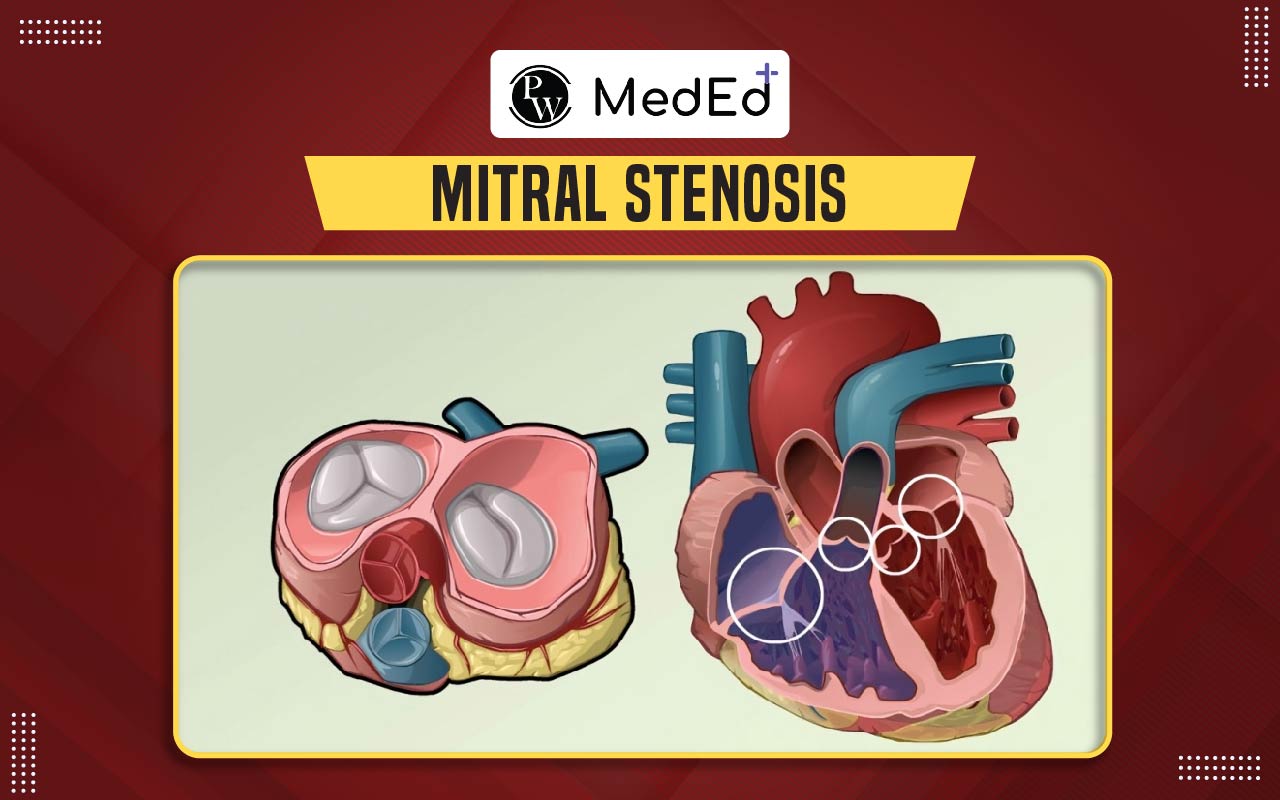

Mitral Stenosis , or Mitral Valve Stenosis, is rare when the valve between two heart chambers on the left side narrows, making it hard for blood to flow correctly. This can make you feel tired and out of breath, and you might have other symptoms like irregular heartbeats, dizziness, chest pain, or coughing up blood. Sometimes, people don't feel any symptoms.
Treatment for mitral valve stenosis might include taking medicine or having surgery to repair or replace the valve. Some people just need regular checkups with their doctor. The article provides information on the symptoms, diagnosis, treatments, and causes of Mitral stenosis, which is helpful for candidates seeking a career in medicine.Mitral Stenosis Symptoms
Mitral valve stenosis is more common in developing countries where access to antibiotics and medical care is limited. It's more likely to occur in people who are female at birth, with cases usually diagnosed in their 50s and 60 s in developed countries and younger adults in developing countries. In infants and children, most cases are found before the age of 2. It may also run in families, increasing the risk if a relative has it. The common symptoms include the following:- Shortness of breath : Feeling out of breath, especially during activity or when lying down.
- Fatigue: Feeling extremely tired, making it hard to do regular activities.
- Bronchitis: Getting lung infections more often than usual.
- Heart palpitations: Feeling your heart beating irregularly can happen when the upper chamber of your heart is under pressure.
- Stroke: Blood clots form in the heart and travel to the brain, causing a stroke.
- Coughing up blood: Blood in your cough can happen when there's pressure on the veins in your lungs.
- Hoarseness : Your voice may change with pressure on the nerve near your heart.
- Swelling: Fluid builds up in your belly, ankles, or feet because your heart struggles to pump correctly.
Symptoms in Children Born with Mitral Stenosis
The symptoms observed in infants and children are described below:- Difficulty feeding or sweating during feeding is a common sign in infants.
- Coughing, wheezing, or having trouble breathing.
- Slowed growth means they may be smaller or lighter than kids their age.
- Getting sick often with respiratory infections.
- Feeling out of breath, especially during activities, can tire them quickly.
Mitral Stenosis Pathophysiology
Pathophysiology is a branch of study that studies how diseases affect the system of the body, combining the techniques of pathology and physiology . The details of Mitral Stenosis Pathophysiology involves the following information:- The mitral valve controls blood flow between the heart's left atrium and ventricle.
- Blood flow is restricted when it narrows (stenosis), causing pressure differences.
- This pressure build-up can lead to conditions like pulmonary hypertension.
- The left atrium enlarges with time, increasing the risk of irregular heartbeats.
- Severe stenosis can result in heart failure and reduced cardiac output.
- Symptoms progress gradually, starting from mild signs to more severe heart issues.
Mitral Stenosis Causes
To know why mitral valve disease is caused, it's helpful to understand how the heart works. The heart has four valves, including the mitral valve, which help direct blood flow . These valves have flaps that open and close during each heartbeat. If a valve doesn't work right, it can make it hard for blood to flow correctly. The major causes of this disease are discussed below:- Rheumatic Mitral Stenosis : When untreated strep throat leads to rheumatic fever, it can damage the mitral valve over time, causing it to narrow. This condition is rheumatic mitral valve disease; symptoms may not appear until years after the fever.
- Calcium Deposits: As you age, calcium deposits can build up around the mitral valve, a condition called mitral annular calcification (MAC). This buildup can narrow the valve, leading to symptoms of mitral stenosis. Severe MAC can be challenging to treat, even with surgery, and may affect the aortic valve as well.
- Radiation Therapy : Radiation treatment for certain cancers, especially in the chest area, can cause the mitral valve to thicken and harden over time. This damage typically occurs two to three decades after radiation therapy.
- Congenital Heart Defects : In rare cases, babies may be born with a narrowed mitral valve, which can cause problems as they grow older. These defects are present at birth and may be revealed as mitral valve stenosis later in life.
- Other Health Conditions: Conditions like lupus and other autoimmune disorders can occasionally contribute to the development of mitral valve stenosis, though this is rare.
Mitral Stenosis Diagnosis
Your regular doctor may find signs of Mitral stenosis during a checkup and send you to a specialist. A key sign they might notice is a heart murmur, which they can hear using a stethoscope during a routine exam. Severe cases may cause multiple sounds in the murmur, helping the doctor assess its seriousness. The standard Diagnosis Technique includes the following:- Echocardiogram: This is the most common test. It uses ultrasound waves to create images of the heart's structure and function, allowing the doctor to see the condition of the mitral valve.
- Electrocardiogram (ECG or EKG): This test measures the heart's electrical activity by placing electrodes on the chest. It can detect irregular heart rhythms associated with mitral valve stenosis.
- Chest X-ray: X-rays are taken to visualize the heart and lungs. Changes in the shape or size of the heart due to mitral valve stenosis can be seen on the X-ray.
- Cardiac Catheterization: In this procedure, a thin tube is inserted into a blood vessel and guided to the heart. It helps measure pressures inside the heart chambers and checks the severity of mitral valve stenosis.
Mitral Stenosis Stages
The severity of the mitral valve disorder is called the stages of mitral valve disorder.- The stages of mitral valve stenosis are described in the points below
- Mitral valve stenosis is categorized into stages A to D.
- Each stage indicates the severity of the condition, with stage D being the most severe.
- Healthcare providers monitor the condition to detect irregularities in the appearance or function of the mitral valve.
- Stages C and D are associated with severe problems, but symptoms typically don't appear until stage D.
Mitral Stenosis Treatment
Treatment for mitral valve stenosis can help manage symptoms, but it can't cure the condition. It's crucial to start treatment once you have symptoms because the problem is usually more severe. Valve repair or replacement surgeries can provide relief for many years, while medications can also help prevent complications. The treatment involves the following techniques:- Catheter-Based Procedures: During these procedures, a doctor puts a thin tube, called a catheter, into an artery in your body. They guide it up to your heart to repair or swap out your valve.
- Valvuloplasty: A catheter with a balloon on the end is used to widen the narrowed area of your mitral valve.
- Valve Replacement: Sometimes, a valve can be replaced using a catheter. This is known as transcatheter mitral valve replacement or TMVR.
- Surgery: Surgery can repair or replace your mitral valve. Surgeons use various methods, like minor cuts or robots. For those with rheumatic heart disease, surgery may unstick valve parts. The doctor chooses between fixing or swapping the valve, using animal tissue, artificial materials, or both.
Mitral Stenosis Prevention
There are specific preventive measures to be followed for mitral stenosis; these include the following listed below:- Treatment of Infections : Timely treating bacterial infections can help prevent mitral valve stenosis.
- Healthy Lifestyle: Maintaining a healthy lifestyle through regular exercise and a balanced diet can contribute to prevention.
- Regular Medical Checkups: Scheduled checkups with healthcare providers allow for early detection of developing conditions.
- Limitations in Prevention: Unfortunately, congenital mitral stenosis cannot be prevented as it occurs from birth.
Mitral Stenosis FAQs
What is the primary function of Mitral Valve?
The mitral valve is one of the four valves in the heart. It regulates the blood flow from the upper left chamber into the lower left chamber.
What is the other name for mitral valve?
The mitral valve is also called bicuspid valve, and the left atrioventricular valve.
Where is the Mitral valve located?
It is located between the left atrium and the left ventricle.
Which valve is best for the heart?
Mechanical valves for people under age 50 and biological valves for those over 70 are best for the heart.
Talk to a counsellorHave doubts? Our support team will be happy to assist you!

Check out these Related Articles
Free Learning Resources
PW Books
Notes (Class 10-12)
PW Study Materials
Notes (Class 6-9)
Ncert Solutions
Govt Exams
Class 6th to 12th Online Courses
Govt Job Exams Courses
UPSC Coaching
Defence Exam Coaching
Gate Exam Coaching
Other Exams
Know about Physics Wallah
Physics Wallah is an Indian edtech platform that provides accessible & comprehensive learning experiences to students from Class 6th to postgraduate level. We also provide extensive NCERT solutions, sample paper, NEET, JEE Mains, BITSAT previous year papers & more such resources to students. Physics Wallah also caters to over 3.5 million registered students and over 78 lakh+ Youtube subscribers with 4.8 rating on its app.
We Stand Out because
We provide students with intensive courses with India’s qualified & experienced faculties & mentors. PW strives to make the learning experience comprehensive and accessible for students of all sections of society. We believe in empowering every single student who couldn't dream of a good career in engineering and medical field earlier.
Our Key Focus Areas
Physics Wallah's main focus is to make the learning experience as economical as possible for all students. With our affordable courses like Lakshya, Udaan and Arjuna and many others, we have been able to provide a platform for lakhs of aspirants. From providing Chemistry, Maths, Physics formula to giving e-books of eminent authors like RD Sharma, RS Aggarwal and Lakhmir Singh, PW focuses on every single student's need for preparation.
What Makes Us Different
Physics Wallah strives to develop a comprehensive pedagogical structure for students, where they get a state-of-the-art learning experience with study material and resources. Apart from catering students preparing for JEE Mains and NEET, PW also provides study material for each state board like Uttar Pradesh, Bihar, and others
Copyright © 2025 Physicswallah Limited All rights reserved.
Get App











